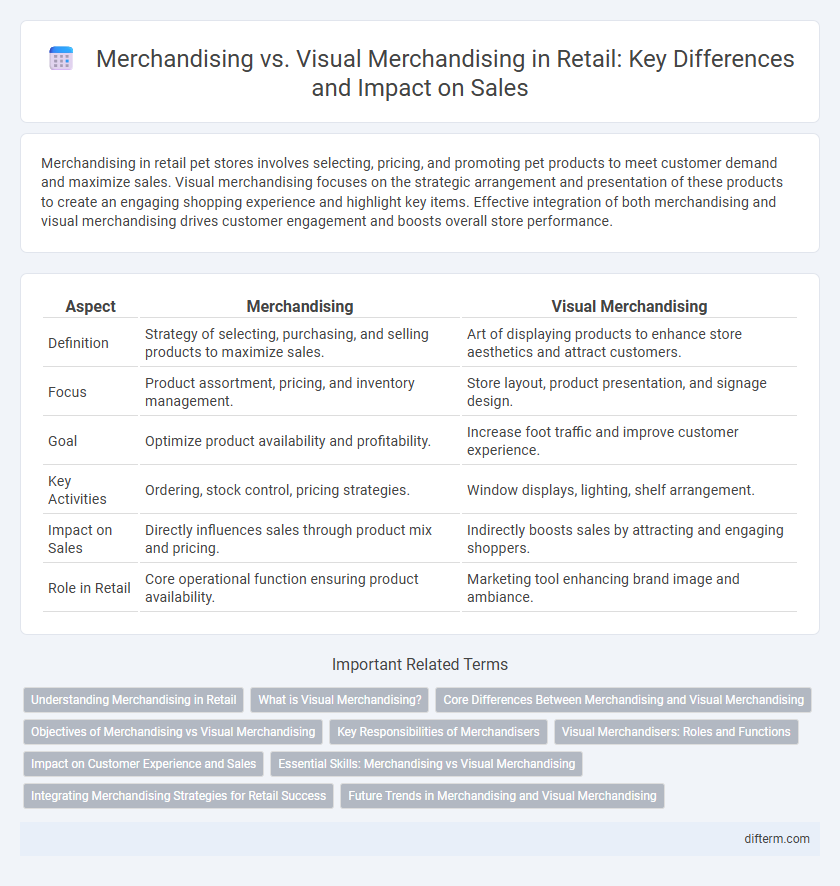Merchandising in retail pet stores involves selecting, pricing, and promoting pet products to meet customer demand and maximize sales. Visual merchandising focuses on the strategic arrangement and presentation of these products to create an engaging shopping experience and highlight key items. Effective integration of both merchandising and visual merchandising drives customer engagement and boosts overall store performance.
Table of Comparison
| Aspect | Merchandising | Visual Merchandising |
|---|---|---|
| Definition | Strategy of selecting, purchasing, and selling products to maximize sales. | Art of displaying products to enhance store aesthetics and attract customers. |
| Focus | Product assortment, pricing, and inventory management. | Store layout, product presentation, and signage design. |
| Goal | Optimize product availability and profitability. | Increase foot traffic and improve customer experience. |
| Key Activities | Ordering, stock control, pricing strategies. | Window displays, lighting, shelf arrangement. |
| Impact on Sales | Directly influences sales through product mix and pricing. | Indirectly boosts sales by attracting and engaging shoppers. |
| Role in Retail | Core operational function ensuring product availability. | Marketing tool enhancing brand image and ambiance. |
Understanding Merchandising in Retail
Merchandising in retail encompasses the strategic planning and execution of product selection, pricing, and promotion to maximize sales and customer satisfaction. It involves inventory management, product assortment, and market analysis to align offerings with consumer demand and seasonal trends. Effective merchandising drives store profitability by ensuring the right products are available at the right time and price point.
What is Visual Merchandising?
Visual merchandising is the strategic practice of designing and arranging retail displays to enhance the overall shopping experience and attract customer attention. It incorporates elements such as lighting, color schemes, signage, and product placement to create an appealing store environment that drives sales. Unlike general merchandising, which focuses on product assortment and inventory management, visual merchandising emphasizes aesthetics and customer engagement through spatial design.
Core Differences Between Merchandising and Visual Merchandising
Merchandising involves product selection, pricing strategies, and inventory management to maximize sales and profitability, focusing on what products to sell and how to promote them. Visual merchandising centers on creating appealing store layouts, displays, and atmospheres that enhance customer experience and drive purchase behavior through strategic use of lighting, color, and spatial design. The core difference lies in merchandising managing product mix and marketing tactics, while visual merchandising emphasizes aesthetic presentation and customer engagement within the retail space.
Objectives of Merchandising vs Visual Merchandising
Merchandising focuses on optimizing product assortment, pricing, and inventory management to maximize sales and profitability by meeting consumer demand efficiently. Visual merchandising aims to enhance the in-store experience through strategic product placement, attractive displays, and ambiance that engage customers and encourage purchases. Both disciplines work synergistically to drive retail success by balancing operational goals with compelling presentation.
Key Responsibilities of Merchandisers
Merchandisers are responsible for product selection, inventory management, and pricing strategies to maximize sales and profitability. They analyze market trends, coordinate with suppliers, and ensure optimal stock levels to meet consumer demand. Effective merchandising drives product availability and promotional planning, directly influencing retail performance.
Visual Merchandisers: Roles and Functions
Visual merchandisers design and implement store layouts, displays, and product presentations to enhance the shopping experience and maximize sales. They analyze customer behavior and seasonal trends to strategically position merchandise, ensuring brand consistency and visual appeal. Their roles also include collaborating with marketing teams and store managers to create immersive environments that attract and retain customers.
Impact on Customer Experience and Sales
Merchandising focuses on product assortment, pricing, and placement strategies to maximize sales and profitability, directly influencing inventory turnover and average transaction value. Visual merchandising enhances the in-store environment through strategic use of displays, lighting, and signage, shaping customer perceptions and encouraging longer store visits. Combining effective merchandising and visual merchandising drives higher customer engagement, leading to increased conversion rates and overall revenue growth in retail.
Essential Skills: Merchandising vs Visual Merchandising
Essential skills in merchandising include inventory management, sales analysis, and product assortment planning to optimize stock levels and meet consumer demand. Visual merchandising requires expertise in display design, space planning, and consumer psychology to create engaging in-store experiences that drive purchases. Both disciplines demand an understanding of market trends and customer behavior but apply these insights differently to maximize retail performance.
Integrating Merchandising Strategies for Retail Success
Integrating merchandising and visual merchandising strategies enhances retail success by aligning product assortment, pricing, and promotions with compelling store layouts and displays that attract and engage customers. Effective merchandising ensures the right products are available, while visual merchandising emphasizes aesthetic presentation and sensory appeal, creating an immersive shopping experience. Combining these approaches drives sales, improves customer satisfaction, and strengthens brand identity within competitive retail environments.
Future Trends in Merchandising and Visual Merchandising
Future trends in merchandising emphasize data-driven inventory management and personalized customer experiences fueled by AI and machine learning. Visual merchandising is evolving with augmented reality (AR) and interactive digital displays to create immersive in-store environments that enhance consumer engagement. Sustainability and ethical sourcing are becoming integral to both merchandising strategies and visual presentation, reflecting growing consumer demand for responsible retail practices.
Merchandising vs Visual Merchandising Infographic

 difterm.com
difterm.com